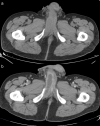Partial thrombosis of the corpus cavernosum - a malignancy mimicker
- PMID: 35136638
- PMCID: PMC8803217
- DOI: 10.1259/bjrcr.20210085
Partial thrombosis of the corpus cavernosum - a malignancy mimicker
Abstract
Partial thrombosis of the corpus cavernosum is a rare condition, typically seen in young patients. Etiology, physiopathology and treatment are still not entirely understood. The authors report a case of a 49-year-old male with gastric cancer, who successfully treated a thrombosis of the corpus cavernosum conservatively. Diagnostic considerations and treatment options are discussed.
© 2022 The Authors. Published by the British Institute of Radiology.
Figures





Similar articles
-
Bilateral partial thrombosis of the corpus cavernosum associated with the use of a stationary bike. Case report and literature review.Urol Case Rep. 2023 May 1;48:102414. doi: 10.1016/j.eucr.2023.102414. eCollection 2023 May. Urol Case Rep. 2023. PMID: 37215056 Free PMC article.
-
Partial segmental thrombosis of the corpus cavernosum.Cent European J Urol. 2011;64(4):264-5. doi: 10.5173/ceju.2011.04.art19. Epub 2011 Dec 9. Cent European J Urol. 2011. PMID: 24578910 Free PMC article.
-
A case of unprovoked segmental proximal partial thrombosis of the corpus cavernosum.Urol Case Rep. 2023 May 10;48:102426. doi: 10.1016/j.eucr.2023.102426. eCollection 2023 May. Urol Case Rep. 2023. PMID: 37215060 Free PMC article.
-
Idiopathic Partial Thrombosis (IPT) of the Corpus Cavernosum: A Hypothesis-Generating Case Series and Review of the Literature.J Sex Med. 2015 Nov;12(11):2118-25. doi: 10.1111/jsm.13036. Epub 2015 Nov 9. J Sex Med. 2015. PMID: 26553854 Review.
-
Partial segmental thrombosis of the corpus cavernosum: a case report and a review of the literature.Urology. 2012 Mar;79(3):708-12. doi: 10.1016/j.urology.2011.11.032. Urology. 2012. PMID: 22386425 Review.
Cited by
-
Utility of contrast enhanced ultrasound (CEUS) in penile trauma.Insights Imaging. 2023 Sep 25;14(1):158. doi: 10.1186/s13244-023-01499-2. Insights Imaging. 2023. PMID: 37749287 Free PMC article. Review.
References
Publication types
LinkOut - more resources
Full Text Sources

